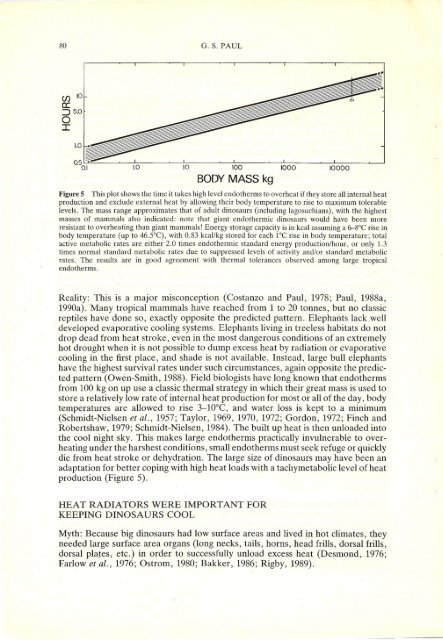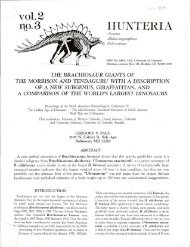THE MANY MYTHS, SOME OLD, SOME NEW, OF ... - Gregory S. Paul
THE MANY MYTHS, SOME OLD, SOME NEW, OF ... - Gregory S. Paul
THE MANY MYTHS, SOME OLD, SOME NEW, OF ... - Gregory S. Paul
You also want an ePaper? Increase the reach of your titles
YUMPU automatically turns print PDFs into web optimized ePapers that Google loves.
80 G. S. PAUL<br />
(f) 10<br />
ex:<br />
::J 5.0<br />
o<br />
I<br />
1.0 10 100<br />
BODY MASS kg<br />
1000 10000<br />
Figure 5 This plot shows the time it takes high level endotherms to overheat if they store all internal heat<br />
production and exclude external heat by allowing their body temperature to rise to maximum tolerable<br />
levels. The mass range approximates that of adult dinosaurs (including lagosuchians), with the highest<br />
masses of mammals also indicated: note that giant endothermic dinosaurs would have been more<br />
resistant to overheating than giant mammals! Energy storage capacity is in kcal assuming a 6--8°e rise in<br />
body temperature (up to 46.5"C), with 0.83 kcal/kg stored for each loe rise in body temperature; total<br />
active metabolic rates are either 2.0 times endothermic standard energy production/hour, or only 1.3<br />
times normal standard metabolic rates due to suppressed levels of activity and/or standard metabolic<br />
rates. The results are in good agreement with thermal tolerances observed among large tropical<br />
endotherrns.<br />
Reality: This is a major misconception (Costanzo and <strong>Paul</strong>, 1978; <strong>Paul</strong>, 1988a,<br />
1990a). 'Many tropical mammals have reached from 1 to 20 tonnes, but no classic<br />
reptiles have done so, exactly opposite the predicted pattern. Elephants lack well<br />
developed evaporative cooling systems. Elephants living in treeless habitats do not<br />
drop dead from heat stroke, even in the most dangerous conditions of an extremely<br />
hot drought when it is not possible to dump excess heat by radiation or evaporative<br />
cooling in the first place, and shade is not available. Instead, large bull elephants<br />
have the highest survival rates under such circumstances, again opposite the predicted<br />
pattern (Owen-Smith, 1988). Field biologists have long known that endotherms<br />
from 100 kg on up use a classic thermal strategy in which their great mass is used to<br />
store a relatively low rate of internal heat production for most or all of the day, body<br />
temperatures are allowed to rise 3-lO o C, and water loss is kept to a minimum<br />
(Schmidt-Nielsen et al., 1957; Taylor, 1969, 1970,1972; Gordon, 1972; Finch and<br />
Robertshaw, 1979; Schmidt-Nielsen, 1984). The built up heat is then unloaded into<br />
the cool night sky. This makes large endotherms practically invulnerable to overheating<br />
under the harshest conditions, small endotherms must seek refuge or quickly<br />
die from heat stroke or dehydration. The large size of dinosaurs may have been an<br />
adaptation for better coping with high heat loads with a tachyrnetabolic level of heat<br />
production (Figure 5).<br />
HEAT RADIATORS WERE IMPORTANT FOR<br />
KEEPING DINOSAURS COOL<br />
Myth: Because big dinosaurs had low surface areas and lived in hot climates, they<br />
needed large surface area organs (long necks, tails, horns, head frills, dorsal frills,<br />
dorsal plates, etc.) in order to successfully unload excess heat (Desmond, 1976;<br />
Farlow et al., 1976; Ostrom, 1980; Bakker, 1986; Rigby, 1989).









